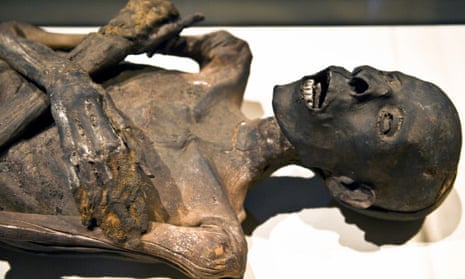Bronze age Britons may have mummified their dead by tossing them into peat bogs or smoking them over a fire, according to archaeologists who have studied the bones of hundreds of ancient locals.
The leathery corpses may have been kept in homes for decades and rolled out for special occasions, or used to assert families’ legal rights to the land their deceased ancestors had worked in the distant past, they said.
Researchers who saw signs of mummification in the bones of individuals from Kent to Cladh Hallan said the practice seemed to be “widespread”, if not always successful at preserving whole bodies.
In some cases, mummification was apparently only partially effective, preserving an arm here and a leg there. On occasion, the best-preserved parts from different people were cobbled together to form a composite body that was buried later on.
“It is highly possible they were curated for some time,” said Tom Booth, an archaeologist who conducted the bone study at the University of Sheffield. “In other cultures they could be kept for ancestor worship, or used as a conduit to speak to the dead.”
In bronze age Britain, the intensification of agriculture and social changes that put more power into the hands of the elite, may have given the mummies a posthumous role in settling land disputes. “Bringing out your dead ancestor who farmed the piece of land is better than producing a land deed,” said Booth, whose work appears in the journal, Antiquity.
The study of Britain’s ancient death rituals arose after researchers noticed that mummified bodies had telltale signatures in their bone structure. When bodies are put straight into graves, gut bacteria leak out and attack the bones to leave narrow tunnels in them. But these bacterial tunnels are not seen in the bones of buried mummies, because they are preserved beforehand.
One body the scientists inspected had been partially mummified in a peat bog in Ireland. Its bones were almost pristine, with very little sign of microbial tunnelling. The same level of preservation was seen in a prehistoric mummy from northern Yemen.
The scientists went on to examine more than 300 bone fragments of ancient people from 26 sites across the British Isles, including Kent, Teeside, Cambridgeshire and Cladh Hallan in the Western Isles of Scotland. Of the 34 individuals dating from 4000BC to modern times, 16 appeared to have been mummified. All were from the bronze age, between 2200BC and 700BC.
Some bone pieces from Kent showed signs of being burned, a hint that the individuals were perhaps preserved by smoking them over a fire. Others may simply have been left in the sun to dry out.
“Mummification was widespread around Britain, though who was treated this way and how often is difficult to say,” said Booth, who is now a researcher at the Natural History Museum in London. Many people who lived in the bronze age were not buried at all, and may have been cremated, or put into waterways, or simply left to decompose on the ground.
“Our research shows that smoking over a fire and purposeful burial within a peat bog are among some of the techniques ancient Britons may have used to mummify their dead. Other techniques could have included evisceration, in which organs were removed shortly after death,” Booth added.
The findings shed rare light on the funerary practices of ancient Britons who appear to have indulged in a variety of forms of mummification for hundreds of years. The researchers now hope to use the same bone test to look at the remains of bronze age communities on mainland Europe.

Comments (…)
Sign in or create your Guardian account to join the discussion